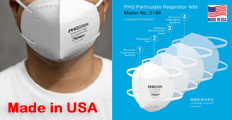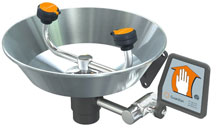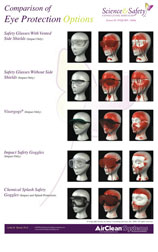



Find all of your laboratory and workplace safety supplies at Safety Emporium!
 Nausea |
 Glossary Index |
 Neoplasm |
| MSDS Topics |
Free Sites | FAQ's | Regulations | Glossary | Software | Suppliers |
| Books | Forum | Poll | Fun stuff | Quiz | Store | |
| Understand your MSDS with the MS-Demystifier | Search ALL our MSDS info | |||||
Necrosis is the death of cells or tissue due to disease, injury, exposure to chemical agents, radiation etc.

Work safely around corrosive materials with eye/face washes, safety showers, drench hoses and more from Safety Emporium.
Necrotic tissue can be found anywhere in the body, but is generally a localized phenomenon. When extremely large areas of tissue are involved, the condition is generally called gangrene. There are many causes of necrosis that go beyond the scope of this resource so we will only discuss the most common occupational cause here, exposure to corrosive materials. See Further Reading (below) for additional information.
Most acids produce coagulation necrosis when they contact bodily tissue, a process that produces an insoluble mass that limits the penetration of the acid and limits the damage. Most bases (as well as hydrofluoric acid) cause liquefaction necrosis which turns the affected tissue to a liquid that does not stop the penetration. Therefore while getting either on your skin or eyes is dangerous, exposure to bases can cause more damage than acids, particularly if not promptly treated. Always seek medical advice after splashing a base into your eye even if it feels OK after initial rinsing.
Two terrifying incidents of quick-onset necrosis from the subcutaneous injection of methylene chloride, a common halogenated laboratory solvent, have been reported in the recent scientific literature. The most recent, from ACS Cent. Sci. 2020, 6(2), pp 83-86 (https://pubs.acs.org/doi/10.1021/acscentsci.0c00100), was a report of worker who almost lost a finger after accidentally sticking himself with a nearly empty syringe. An earlier report of a deliberate injection also involved significant tissue damage; see Asia Pacific J Med Toxicology 2018, 7(3), pp 84-85 (https://dx.doi.org/10.22038/apjmt.2018.11981). The Safety Data Sheets in these cases did not address injection as a route of entry, presumably because of the rarity of such events. In light of these reports, it is best to assume that other solvents may pose similar unreported/unknown risks that will not be found on the SDS. In fact, we have since received two unpublished second-hand reports about similar accidents, one from injection of a high-boiling hydrocarbon mixture residue that resulted in amputation, and the other involving injection of water-based paint from a spray gun nozzle that resulted in severe finger injury.
Necrosis usually appears on a Safety Data Sheet as a delayed or immediate symptom of exposure, usually through eye or skin contact. Corrosive materials may cause painful chemical burns and necrosis of the skin or eyes. Section 11 (toxicological information) of the SDS will list the symptoms of exposure and Section 4 (first-aid measures) will list first aid measures. However, as demonstrated by the discussion of methylene chloride injection above, unknown risks will obviously not appear on an SDS. Therefore, it is critical to always maintain proper chemical hygiene practices regardless of that the SDS says (or doesn't say).
Always review your SDS before using a chemical so you know how to protect yourself from the listed hazards. Wear proper personal protective equipment (PPE) such as gloves and goggles when dealing with such materials and consult Section 8 (exposure controls/personal protection) for a complete list of preventative measures.
See the entry on eye washes for special considerations/cautions when working with bases. Bases do not flush out of eye tissue very easily compared to other substances and can do extreme damage even after prolonged rinsing. Safety glasses are not sufficient protection when using bases; instead use chemical splash goggles. The poster shown on the below right provides a graphic example of the efficacy of the various types of common safety eyewear versus chemical splashes.

Choosing correct eye protection can make the difference between sight and blindness. Reinforce this lesson with safety posters from Safety Emporium.
See also: gangrene.
Additional definitions from Google and OneLook.
Entry last updated: Friday, January 6, 2023. This page is copyright 2000-2025 by ILPI. Unauthorized duplication or posting on other web sites is expressly prohibited. Send suggestions, comments, and new entry desires (include the URL if applicable) to us by email.
Disclaimer: The information contained herein is believed to be true and accurate, however ILPI makes no guarantees concerning the veracity of any statement. Use of any information on this page is at the reader's own risk. ILPI strongly encourages the reader to consult the appropriate local, state and federal agencies concerning the matters discussed herein.